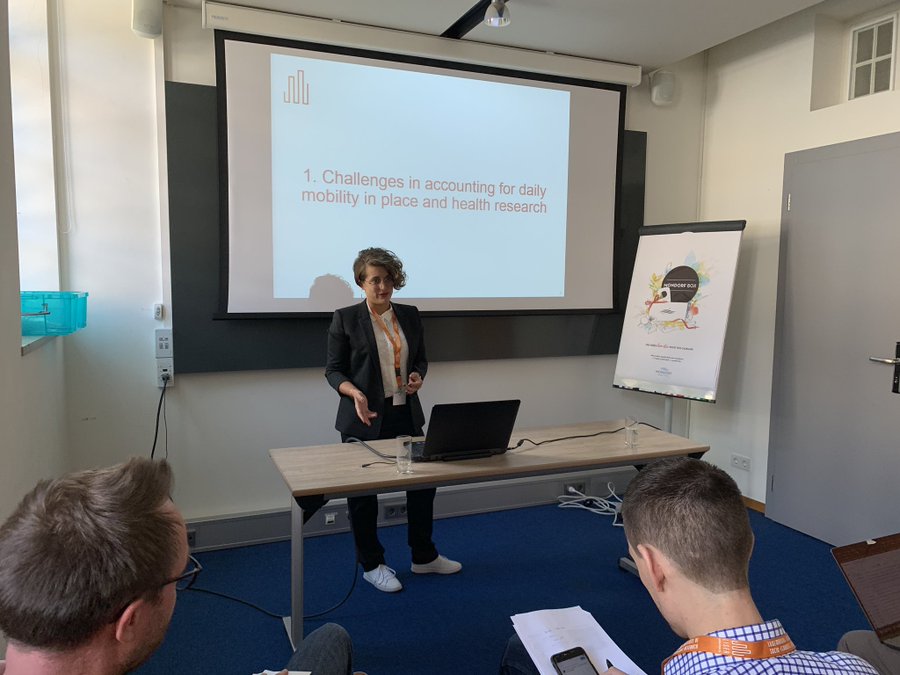In conversation with our young researchers: Dr. Camille Perchoux
20 August 2021

Epidemiology and geography.
Where we live and where we go as the result of our daily activities affect our health.
How much do urban environments have an impact on our active and healthy behaviours, chronic diseases and healthy ageing?
Dr. Camille Perchoux is a young research associate in the Luxembourg Institute of Socio Economic Research (LISER). She focuses on urban health.
A health geographer
Camille Perchoux describes herself as a health geographer. Indeed, her research expertise expends on her multi-disciplinary background in epidemiology and geography. Building on these two research fields, her research focus is on the social and spatial determinants of health behaviours and population health.
In her research, she investigates the impact of urban environments on active and healthy behaviours, chronic diseases and healthy ageing. Indeed, physical environmental characteristics, and social aspects of neighbourhood constitute urban structures of opportunities that enhance or constrain individual’s health related behaviours such as leisure physical activity, active transport, or adopting a healthy diet in daily life, which are key determinants of mental and physical health.
In order to more comprehensively assess people place interaction, and understand people decision making process in adopting (or not) health behaviours, Camille Perchoux and her colleagues in LISER are increasingly relying on GPS trackers to understand where people go, accelerometers to estimate their amount of energy expenditure and related transportation modes, and additional mobile sensors to accurately measure either personalised exposure to environmental factors or health related markers.

“This multidisciplinary research thematic is at the crossroads of public health policy, transport policy and land use as well as urban planning.”
Dr. Camille Perchoux
The promotion of strategies for adopting and maintaining healthy and active lifestyles is a public health priority to curb the cardiometabolic diseases, among others, and related severe impact on well-being.
In this regard, her research tends to identify socio-demographic and environmental levers that can provide element of decision-making to support the implementation of intervention at the individual level and their environment.
Research as a natural career path
While Camille Perchoux was a master student in geography, at Provence university, she had the chance to study the geography of malaria during two successive internships in Brazzaville, Congo, and in Dakar, Senegal.
“[During my master] I had the opportunity to do some field work, develop a survey, sample and survey the participants, work with researchers from public health and geography, and disseminate the results to the local stakeholders. After such an enriching experience of the different tasks that make up the daily work of a researcher, research was the only work I could picture myself doing at the end of my master degree.”
Dr. Camille Perchoux
After completing her Master’s degree, she joined a multidisciplinary research team to conduct a dual PhD thesis in public health – epidemiology at Sorbonne university – Pierre et Marie Curie Paris 6 (France), and at Montreal university (Canada). During her PhD, she examined the residential and non-residential neighbourhood environments that individuals experience as the results of their daily activities and may influence their health behaviours, with a case study on recreational walking.
Indeed, while more traditional approaches focused exclusively on the effect on residential neighbourhood characteristics on health, a significant innovation of this work was to highlight and quantify how individuals’ daily mobilities and daily activities outside their residential neighbourhood may also contribute to shape their health.
Then she joined the Centre de Recherche en Nutrition Humaine Rhône-Aples (CRNH-RA) in 2015 where she continued developing a strong taste for multidisciplinary work, being part of the ACTI-Cités consortium that embraces a team of epidemiologists, nutritionists and geographers to examine the socio-ecological determinants of active transportation in France. She also joined the DEDIPAC knowledge hub, a multidisciplinary consortium of 68 research centres from 13 countries across Europe, reflecting on the determinants of diet, physical activity and sedentary behaviours.
Camille Perchoux joined LISER in 2016 as a postdoc researcher before being prompted permanent researcher two years later.
Why Luxembourg as a research destination?
Camille Perchoux moved to Luxembourg as LISER was conducting a very innovative study on place effects on health based on map-based questionnaires, sensors and GPS trackers. It was “the perfect opportunity for me to grow as an independent researcher in the fields of neighbourhood and health.”

“Luxembourg applies the highest international standards of research, while the rather small size of the country facilitates the discussion and collaboration between researchers from different disciplines but also between researchers, political actors and stakeholders. Such dialogue between key actors in research and policy, and citizen is key in addressing complex societal challenges such as designing healthy and liveable cities while producing research with a high societal impact.”
Dr. Camille Perchoux
An FNR CORE 2020 grantee
Dr. Camille Perchoux is the principal investigator of the FNR CORE 2020 MET’HOOD project on the “Time-varying residential neighbourhood effects on cardiometabolic health”. Cardio-metabolic diseases are one of the leading causes of premature death worldwide.
“The MET’HOOD project is a joint collaboration between LISER and Luxembourg Institute of Health. It embraces a multidisciplinary team of urban geographers, epidemiologists, nutritionists, and sports scientists, with the support of local stakeholders in public health and urban planning “
Dr. Camille Perchoux
MET’HOOD explores the relationships between the socio-economic and physical environmental characteristics of residential neighbourhoods, behavioural cardiometabolic risk factors such as diet and physical activity, and the metabolic syndrome, over a nine-year period in Luxembourg.
Based on a country-wide, population based longitudinal study, this project will provide solid evidence on how urban density, transport infrastructures, foodscape characteristics and neighbourhood active-friendly characteristics have changed over the last decade in Luxembourg, and how such changes may have resulted in changes in the cardiometabolic health of the population.
About living in Luxembourg
After moving every six months during her PhD in between France and Canada, and then discovering the city of Lyon during her post-doctoral fellowship, Camille Perchoux was eager to discover a new country and a new culture.

“I believe that Luxembourg provides a great opportunity to benefit from natural spaces, in particular nature is accessible by bike and foot, while concentrating the assess of a capital city in terms of diversity to engage in social and leisure activities. Also, being exposed daily to such a great cultural and linguistic diversity provides me a strong sense of belonging to a European community.”
Dr. Camille Perchoux
More about Camille Perchoux








